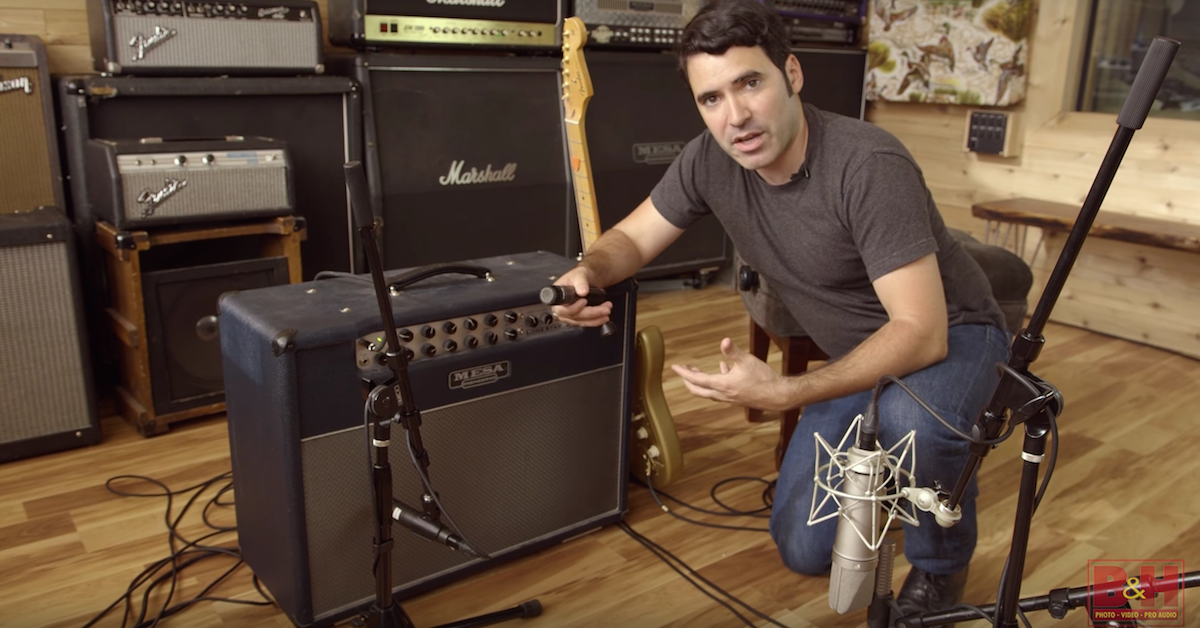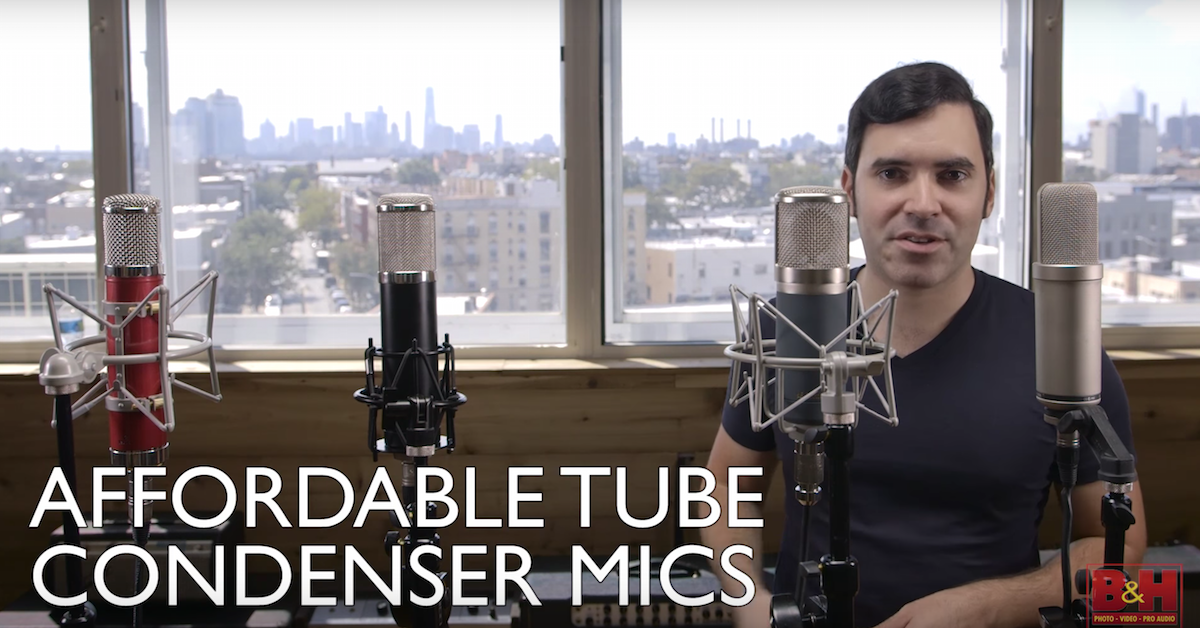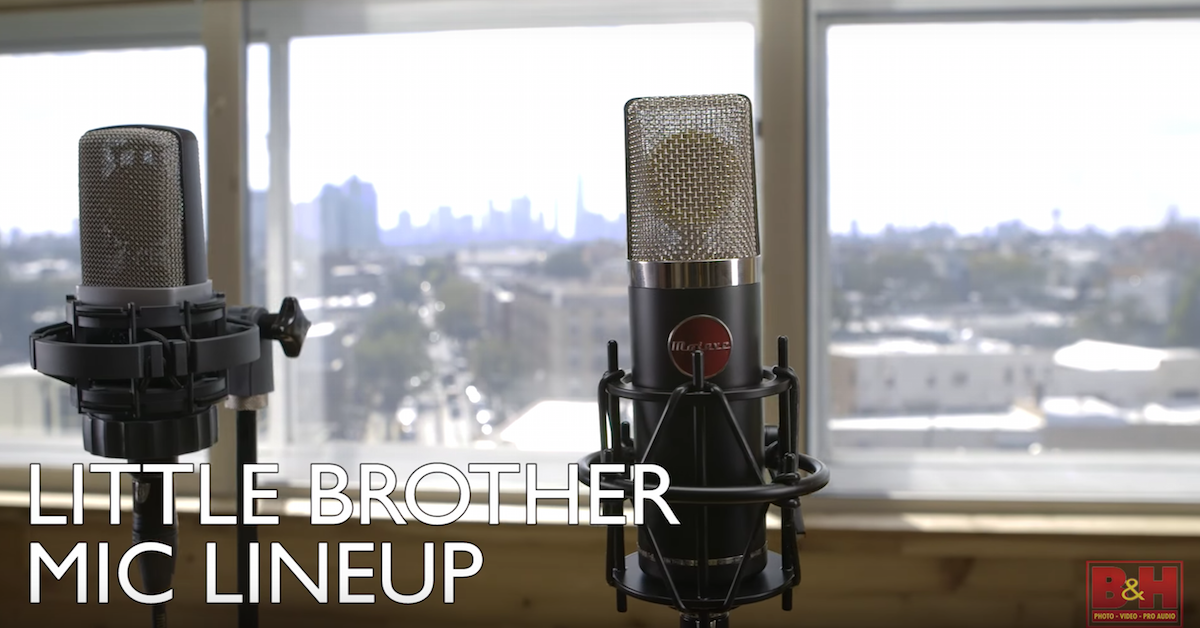Mic Shootout 3: Dynamic Microphones
In our first segment in the series, we looked at some of the most useful microphones that money can buy. Those are mostly $1,000 and up. In the second segment, we looked at more affordable large diaphragm condenser microphones, priced between $300 and say, $700. This time, we’re diving into dynamic mics.
Wes Hutchinson is going to be playing some electric guitar for us to really hear these in context, and we’ll hear vocals on a few of them as well. Thanks to B&H, we’ve got a really cool lineup to walk through, once again, so let’s get started!
The first mic in this series is the Shure SM7b. This is a real studio classic. It’s been used on vocals by a tremendous number of singers, from Michael Jackson to James Hetfield, and everyone inbetween. It’s kind of like the big brother to a Shure SM57, and if I take this piece of foam off, you’ll see the rather large dynamic diaphragm here on the microphone.
On the backside of this microphone, we’ve got some adjustment switches that let you apply a slight high end boost, or a low frequency roll off to the mic, which can be handy, particularly on some vocalists, but also just a real nice sounding mic as is. Folks use this not only on vocals, but on snare drums, electric guitars, I’ve seen people put them inside kick drums. Like I said, almost anything you might want to put a mic in front of, you can get away with putting a Shure SM7b in front of.
Not that expensive of a mic. They do require a fair amount of gain, so you want to make sure you’re using a preamp that can give a fair amount of gain without getting noisy, but so many modern preamps today can do just that.
The next mic in this lineup is one of my personal favorites when it comes to dynamic mics. It is the Sennheiser MD-421 MkII. This is fairly bright for dynamic microphones. There’s a little bit of lift at say, 2kHz and above. It sounds great on electric guitars, snare drums, vocals, horns, toms is a classic application for the MD-421, and I like mine a lot inside a kick drum.
You put it inside a kick drum, you don’t EQ it, you’ve got instant 1970’s drum tone. You do EQ it, it takes to it really well. You can really scoop out the mids and sculpt a much more modern, articulate tone as well. Really flexible mic.
There’s also a switch on here right around the base of the microphone. This is a multi-position switch. It starts at the letter M, which stands for music, and ends at the letter S, which stands for speech. You have it on music, it’s basically flat with a subtle high frequency lift that’s just kind of built into the mic, and as you go closer and closer to speech, you’re rolling off lows and making the microphone brighter and brighter. In the studio, when it comes to working with instruments, I almost always have it on the music setting, but feel free to play around with that switch. You might like it for some sources.
The next mic in our chain here is the RE20. Really classic voice over microphone, vocal microphone, a lot of people love these on bass cabs, because you can get really close to the bass cab with no proximity effect. That’s actually the purpose of these vents that you’ll see on these microphones is to reduce proximity effect while still getting the cardioid pattern.
There’s also a low frequency roll off switch on it. Really great classic sounding microphone. Again, you can get some really kind of cool, retro sounds by sticking it inside of a kick drum. Some folks love these on vocals.
Next mic, you’ve probably seen them before. The Shure SM57. There’s not a knob or a button or a switch on this microphone, but extremely useful studio tool. Great on snare drums, electric guitars, some people even like singing into them, and some people more famous than you might expect like singing into them.
Great all around microphone.
We’ve got a slight variation on this here, the Audix i5. The Audix i5 is kind of an answer to the Shure SM57. They say it sounds even better, and some people agree. It maybe has a little bit more low end oomph, slightly more richness on the bottom than a 57, and just a little bit more fullness, but still a lot of that great presence and articulation that you’d come to expect out of an SM57. Really nice mic as well, we’ll get to hear that one side-by-side an electric guitar with a 57 and you can make your own choice.
Well, again, enough of me talking. I think the best way to experience these mics is to hear them, and if you can’t hear them in your own studio, a great way to hear them is in ours. So let’s hear these! First on electric guitar, then on some vocals.
[Shure SM7b on vocals and guitar]
[Sennheiser MD421-II on vocals and guitar]
[Electrovoice RE20 on vocals and SM57 on guitar]
[Shure SM57 on guitar]
[Audix i5 on guitar]
[Shure SM7b on guitar]
[Sennheiser MD421-II on guitar]
Justin: Alright, we’re back one final time with Gian Stone and Ben Rice of DeGraw Sound. This time, we want to talk about the dynamic mics. We just heard 57, Audix i5, Shure SM7, RE20, and a whole bunch of cool stuff. Any favorites out of the bunch you think really stood out?
Gian: 57. [laughs] They’re great mics. I mean, we were talking about this months ago. I was setting up a guitar amp, and somebody’s like, “Can you put up a 421?” And I was like, “Sure, it’s a great mic.” So I put it up, and I was like, “It’s not quite there.” You know, it’s not necessarily what I’m looking for. Then put up the SM7. It’s close, it sounds great, but it’s not a 57. It’s like, that’s the sound! It just works really, really well.
Justin: It sounds like a record because you’ve heard it on so many damn records, right?
Ben: That’s what we know electric guitars to sound like. If it ain’t broke, don’t fix it.
Justin: Well, how about the ones we heard on vocals? We had the SM7, the RE20, and the 421. Was there anything that kind of stood out there for you?
Ben: Probably the 7b is what I would use the most. I think the 421 is probably the least usable as a go-to vocal mic, but it has a kind of cool quality. But both — I think both the 7b and the RE20 are pretty good across the board.
Justin: Did you have any preferences there when it came to vocals?
Gian: I love the SM7b, but I really like the RE20 as well, and the 421, it did have a little bit of a plosive problem, but it’s a great sounding mic. They all sounded great, but I think the SM7 is my favorite of the bunch, but the RE20 also sounds great.
Justin: I hear you. I agree, my go-to would probably be the SM7. It probably sounded the most full bodied out of this bunch, probably the thickest, and you can adjust that a little bit by doing the high frequency boost that’s built in, the low frequency roll off that’s built in. I find a lot of engineers are afraid of switching those, but I use them sometimes. They sound — I hear you, they sound too thick, I’ll use them, but I was surprised by the 421 on him in particular. It just had this really bright, airy, almost kind of pleasant quality about it.
It wouldn’t be the first one I’d run to, but on the right singer, I could see that extra air and high frequency push being cool, but sometimes I could see it not working. The SM7 is probably the most surefire one.
Gian: It kind of sounded like it just sat on the track in a really nice way, which a lot of times, you have to use EQ to get to happen, but that was like the really great thing, so I think the setting we were using it was more of a minimal setup. Maybe we wanted it to sit a little more in the track possibly, but if you’re doing a Pop record or something where you kind of want something…
Justin: Yeah, in a dense thing, it sounds kind of already EQ’d.
Gian: Yeah.
Justin: I hear you. Yeah, really great observation. And the electric guitar, how did you guys think about the i5 compared to the SM57? You have any preference there? I like the i5 a little bit, but I have to admit, on guitars, the SM57 just kind of has that tone. I would definitely check out that i5 on snare drum. It just adds a tiny bit of extra weight. Sometimes I find myself boosting a little bit at 100Hz on the 57 on the top of the snare, and I feel like the i5 kind of does that a little bit already.
Ben: I use it a bit on the bottom snare. I like the 57 on top and the i5 underneath, but maybe that’s because it just makes it a little more of the — you have a little bit more low end.
Justin: Yeah, it’s such a thin sounding spot, you can use it for —
Ben: Yeah.
I think, I don’t know, just to go back to the 7b, I think that’s just such an amazing microphone across the board, we were talking about this too when we were figuring out, well, should we put that on the guitar, or should we just use that for vocals? And it’s like, you can really use that on pretty much anything, whether it’s a vocal, guitar, bass amp, kick drum, you know, horns, it’s super, super versatile.
Justin: Great desert island mic, right? If you had only one Shure SM7 or a Neumann U87, if you could grab either one of those, maybe one of each, you’d be pretty happy?
Ben: Yeah, those would be the two. Out of all the mics we looked at, those would be the two for me personally, and if I was going to do one from the more low end or affordable bunch, I think that the Rode and the 7b together would be a great pair under $700. You pretty much have everything covered.
Justin: Cover so many bases right there, yeah.
Gian: It’s pretty funny, in our B room, it’s more of a production suite. We use it for overdubs and there’s two mics that we keep on the desk at all times, and that’s a U87 and an SM7, because you know, you just keep a mic stand right there, put it in, and you can pretty much record anything with those mics.
Justin: There you go man, that says a lot.
Alright, well thanks again for taking the time to chat about this stuff. Thanks for having us here at DeGraw, it’s been a lot of fun, and I know that if I were shopping for this stuff for the first time, I would be — this would be super useful to me, so I really appreciate you guys walking through this with us.
Thanks Ben! Thanks Gian. I’ll see you guys next time.
This has been Justin of Sonic Scoop at DeGraw Sound. Thanks again to B&H for having us, I’ll see you next time.





